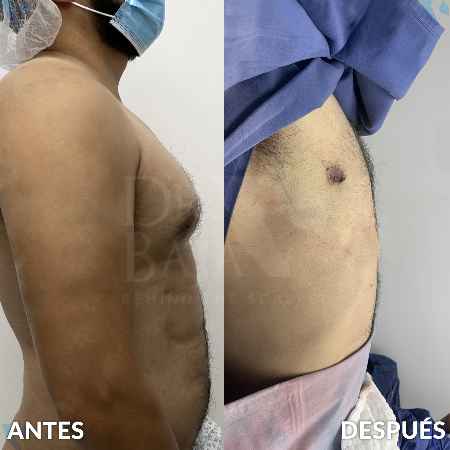If you are thinking about getting a facial fat injection, choose a certified cosmetic surgeon for a safe and successful procedure. Dr. Renato Rodríguez has a lot of experience and has achieved amazing results, where he can restore male breasts to their natural shape. His skills have helped many patients feel happier and more confident.
We understand the importance of this choice and are here to support patients at every stage, providing information and addressing questions from pre-examinations to post-surgery recovery. Our priority is to ensure that they feel comfortable and safe at all times.
Gynecomastia is a surgical procedure designed to address the abnormal enlargement of the mammary glands in men. The severity of gynecomastia can vary in degrees, from mild to severe, and the choice of surgical technique will depend on the degree.

The times may vary depending on the patient.
Procedure duration
1 - 2 hours
Discomfort time
1 day
Recovery time
7 days
Type of anesthesia
Block with sedation
Necessary hospitalization
No
Gynecomastia begins with the administration of anesthesia, strategic incisions are made to remove glandular tissue and perform liposuction, aiming to reduce the size of the male chest and restore its shape. Depending on the degree of gynecomastia, the areola may be adjusted and repositioned for aesthetic results. After the closure of incisions, patients are given postoperative instructions, and the recovery period varies depending on the extent of the surgery.
Gynecomastia is classified into various grades based on the extent and severity of the enlargement of male breast glands. These grades may vary, but a common classification is as follows:
Grade I (Mild):
At this level, gynecomastia is characterized by a noticeable increase in mammary gland without excess skin. The appearance may be similar to an augmentation of tissue in the pectoral area.
Grade II (Moderate):
At this grade, enlargement is more noticeable, with a greater amount of glandular tissue and sometimes with a slight excess of skin. The chest shape begins to deviate from the typical masculine appearance.

Grade III (Severe):
Gynecomastia at this level presents with a significant increase in mammary tissue and may include an evident excess of skin. The chest shape deviates considerably from the masculine, often with an appearance of more prominent breasts.
Grade IV (Very Severe):
In extreme cases, Grade IV gynecomastia involves massive enlargement of the mammary glands, with a considerable excess of skin. The appearance may be more similar to that of female breasts.
It is important to note that the exact classification may vary, and the evaluation conducted by the cosmetic surgeon will determine the specific grade for each case. The recommended treatment will also depend on the grade of gynecomastia.
Includes: Surgeon's fees, surgical equipment, operating room, and outpatient stay in the hospital. Additionally, post-surgical follow-up appointments necessary until discharge are also covered.
Not included: Post-surgical garments, pre-operative tests, and necessary medications.
Gynecomastia is a condition characterized by the enlargement of the mammary glands in men, being mainly caused by hormonal changes that disrupt the balance between male and female hormones. Factors such as puberty, aging, the use of certain medications, underlying medical conditions, and the consumption of recreational substances can contribute to the development of this condition.
Ideal candidates for gynecomastia surgery are men in good overall health with a significant enlargement of the mammary glands. They should have realistic expectations, stable hormone levels, stable body weight, and commitment to postoperative care. It is essential to undergo an assessment with the cosmetic surgeon to determine suitability.
Yes, gynecomastia surgery can leave scars, and their visibility will depend on the degree of gynecomastia. The scar is typically located at a strategic access point on the areola to minimize visibility. The extent of the scar will vary depending on the amount of glandular and fatty tissue that needs to be addressed during the surgery.
The medications recommended after gynecomastia surgery typically include pain relievers to manage discomfort and antibiotics to prevent potential infections.
The risks and potential complications associated with gynecomastia surgery may include the formation of hematoma, accumulation of serous fluid, inflammation, healing issues, risk of infection, and temporary alterations in sensitivity of the skin or nipples.
Experience an exceptional stay in our recovery apartments, just like vacation rentals! Take advantage of this opportunity and discover everything we have to offer you.
Book now





